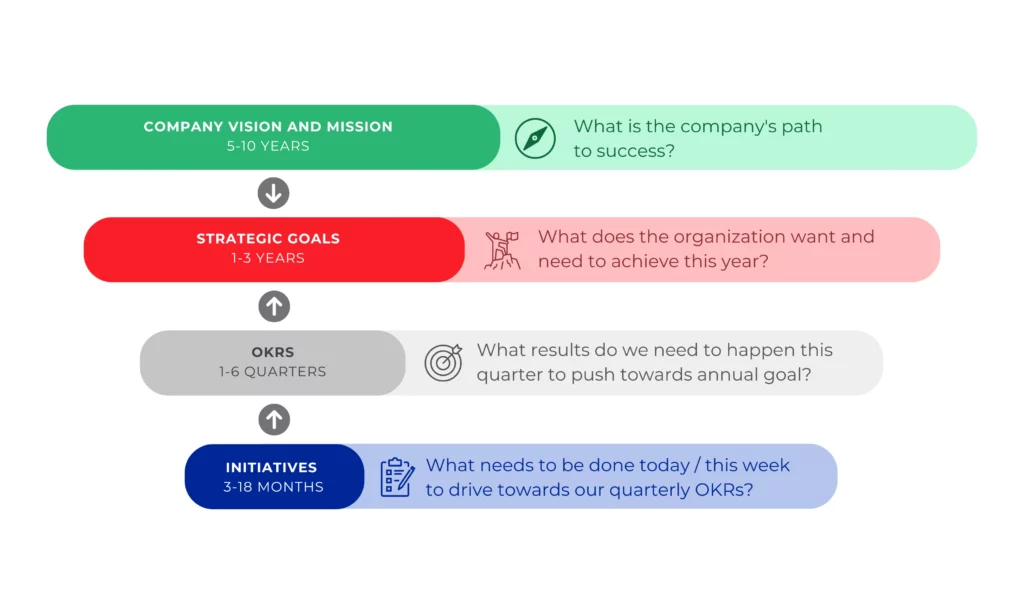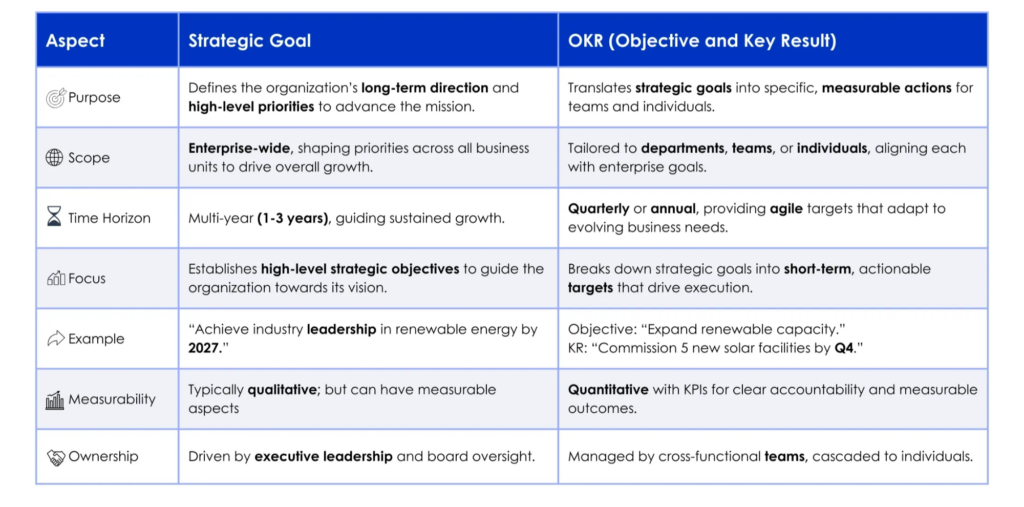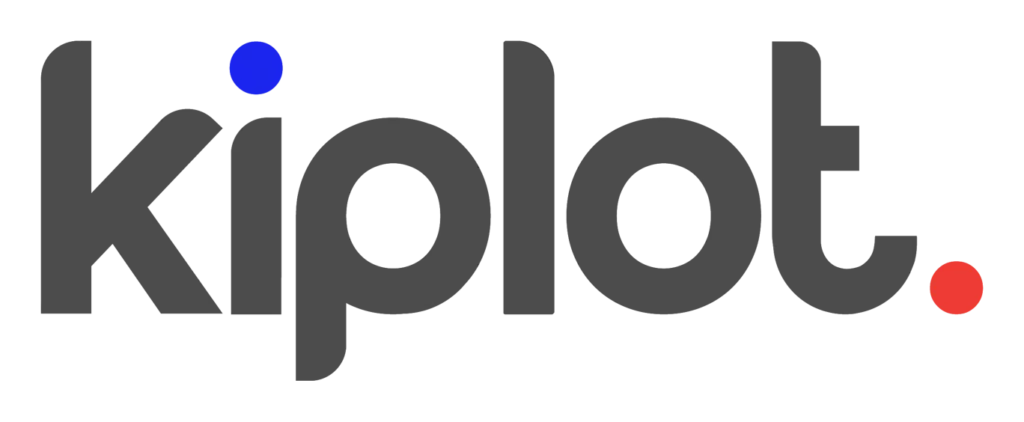Introduction
In a previous article called ‘How to write effective OKRs’ we explored how OKRs are crucial for driving continuous improvement and innovation. In this article, we’ll explore the difference between OKRs (Objectives and Key Results) and higher-level strategic goals and the importance of aligning them.
Whilst Strategic goals and OKRs are both designed to guide the organization towards it’s mission, they differ in both scope and purpose within the organization. Strategic goals set the high-level direction and priorities that guide the company toward its mission, answering what the organization aims to achieve in the long term. OKRs, on the other hand, break these goals down into actionable, measurable steps that specify how each team and individual will contribute to reaching those goals in the short term.
By aligning OKRs with strategic goals, every level of the organization moves cohesively in the same direction. This alignment not only fosters purpose and engagement, as employees see how their work supports the company’s mission, but also enhances cross-team collaboration by ensuring everyone is working toward unified strategic outcomes.
What is the difference between a strategic goal and an OKR?
Whilst OKRs should be inspired by the company’s overall mission and vision, they should not define the company strategy themselves. Rather, OKRs are designed to translate the high-level strategy into specific, short-term actions that drive progress towards these strategic goals.
The diagram below demonstrates a typical funnel with the company mission & vision at the top, all the way down to team initiatives.
image:medium

The company’s mission, vision, and values lay the foundation for effective OKRs, addressing the question, “Where are we headed, and why are we going there?”
Strategic goals define “What do we aim to achieve?”
While OKRs answer “How will we achieve this?”
The Executive Leadership team establishes the mission and vision, then collaborates with Business Unit heads, Value Stream Leads, and other leaders to shape strategic goals and develop aligned OKRs.
The below table summarizes the key differences between the two.

Structuring strategic goals
A helpful framework for structuring strategic goals is the ‘5 Ps’: Profit, Product (or service), People, Promotion & Progress.
Profit – How does the company generate revenue?
This can often be a good place to start as financial growth tends to drive expansion in other areas. This goal often tends to be directed towards the sales and finance team, with aims to increase revenue, reduce operational costs or optimize profit margins.
Example goal: Achieve 30% profit growth whilst maintaining sustainable practices by the end of 2027.
Product (or service) – What does the company offer?
Goals related to product or service development ensure that the organization continues to innovate and stay competitive. This could include refining your product to meet specific customer needs of focusing on enhancements to stay ahead of the competition.
Example goal: Lead the industry in product innovation and quality by 2027.
People – The team powering the organization.
Employees are vital, valuable and costly assets. Goals in this area may focus on hiring, employee engagement, company culture, and efficient business operations. While measuring success here may be less quantifiable than in technical departments, these goals could include increasing employee satisfaction, implementing professional development programs, or fostering cross-department collaboration.
Example goal: Cultivate a high-performance culture that supports growth and innovation.
Promotion – How does the company expand its reach?
Promotion encompasses marketing, advertising, branding, content, and public relations efforts. Goals in this area strengthen brand awareness and broaden customer reach, whether by running campaigns, enhancing social media engagement, or improving conversion rates.
Example goal: Elevate brand visibility and market reputation to become the top choice for customers by 2027.
Progress – What transformative actions will drive the business forward?
Progress represents the forward-looking, high-impact initiatives that will significantly influence the company’s future. Examples might include entering a new market or migrating to an advanced system, with the aim of driving notable, long-term impact.
Example goal: Expand into the European market , capturing 5% market share within the first 3 years.
By setting strategic goals across the 5 Ps, companies ensure a holistic approach to growth, balancing financial health, product relevance, team engagement, and market presence while pursuing ambitious objectives that propel the business forward.
Writing OKRs
OKRs break strategic goals down into actionable, measurable steps that teams can focus on in the short term, translating goals into specific, time-bound objectives with measurable outcomes that teams and individuals can work toward in their day-to-day roles.
Taking two of the examples above, we can see how Objectives and Key Results focus on what needs to be done to achieve the Strategic goal.
Example 1
Strategic Goal: Achieve 30% profit growth whilst maintaining sustainable practices by the end of 2027.
- Objective: Increase revenue from existing customers through upselling.
- Key Result 1: Achieve a 20% increase in average revenue per customer by the end of Q4 through expanded service offerings.
- Key Result 2: Convert 30% of existing customers to a higher pricing tier by the end of Q2 through targeted account management and personalized upsell strategies.
In this example, the strategic goal provides a high-level revenue target and two broad methods to achieve it: pricing optimization and market expansion. The Objective specifies how the pricing model will be optimized and includes Key Results to measure progress, from completing pricing analysis to achieving a target increase in average revenue per customer. Each Key Result gives a clear, quantifiable benchmark, turning a broad revenue goal into actionable steps that the team can prioritize and execute.
Example 2
Strategic Goal: Expand into the European market , capturing 5% market share within the first 3 years.
- Objective: Set up foundational operations in Europe.
- Key Result 1: Hire a regional sales and support team for Europe by the end of Q2.
- Key Result 2: Set up local partnerships with three key distributors by the end of Q3.
This strategic goal outlines the high-level target for European expansion, while the objective specifies a concrete action—establishing foundational operations—to achieve it. The Key Results then provide actionable milestones essential to successful market entry, including building a regional team and forming distributor partnerships. By tracking these Key Results, the team gains a clear view of their progress and can adjust efforts as needed, ensuring that each milestone moves them closer to the strategic goal.
💡 Objectives define what needs to be accomplished to advance the organization’s strategic goals, while Key Results offer specific measures to track the completion of those objectives.
Aligning OKRs to your goals
There are three key principles to follow when aligning OKRs to your strategic goals and we’ll explore each below.
Define clear, consistent measures for effective alignment
A key step in aligning OKRs with strategic goals is to establish clear, consistent “measures”—metrics that specific Key Results can influence or impact. By defining and using these measures across teams, you can more easily quantify progress toward broader organizational goals and ensure alignment at every level.
For example, if we take the the same strategic goal from earlier:
Strategic Goal: Expand into the European market , capturing 5% market share within the first 3 years.
- Objective: Set up foundational operations in Europe.
- Key Result 1: Hire a regional sales and support team for Europe by the end of Q2.
- Key Result 2: Set up local partnerships with three key distributors by the end of Q3.
Selecting the focused measures of regional hiring targets or number of partnerships formed, provides a detailed view of progress, enabling teams to track and influence the key drivers of the strategic goal. Defining measures ensures that each OKR meaningfully supports company priorities, enabling alignment and accurate reporting across teams.
Progress not perfection
Writing and aligning OKRs is an iterative process. With each quarter, your organization will improve at creating, aligning, and achieving OKRs. Focus on progress, not perfection. Start small, ensuring alignment within a subset of teams, and expand gradually from there.
Do not attempt to roll out OKRs across the organization before the organization has had time to understand what they are, and how they work. The best way to start out is to determine a small number of well defined OKRs that are managed at the top of the organization and then incrementally roll out OKRs down.
Continuous feedback
OKRs thrive in an agile environment, where planning and delivery are incremental and teams can adapt quickly based on continuous feedback. It’s important that OKRs are reviewed regularly to ensure teams have a comprehensive and ongoing view of how their efforts are contributing to company goals. Typically OKRs are measured on a quarterly basis as this is long enough for strategic shifts to reflect across teams, but regular enough for teams to understand if they need to ‘course-correct’.
Additionally, this allows teams to find their own rhythm. Whether they prefer daily, weekly, or monthly check-ins, the quarterly review ensures that at least four times a year, progress against larger business objectives is measured, resulting in four learning cycles instead of one per year. OKRs enable agile shifts in focus and alignment within quarters rather than waiting for annual reviews, making OKR adoption highly effective
Conclusion
While strategic goals and OKRs serve distinct roles, aligning them is essential for advancing the company’s mission. Frameworks like the 5 Ps help structure strategic goals, while defining clear and consistent measures ensures alignment across the organization. This agile approach bridges strategy and execution, empowering every level of the organization to drive growth and innovation effectively.
Learn more about Kiplot’s OKR capabilities.
